Moving to Reservations
What do these photos tell you about why Indians were moved to reservations?
White Painting Of Sand Creek
This painting shows soldiers attacking the Indian village at Sand Creek in Kiowa County, Colorado. The attack took place on the night of November 29-30, 1864, against Indians who were at peace with the United States. About 200 Cheyenne and Arapahoes, mostly women and children, were killed in this attack.
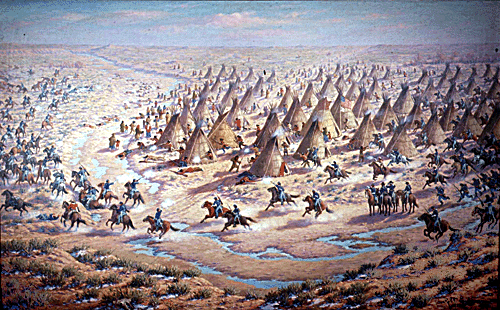
Photo: Colorado Historical Society
More About This Topic
The attack at Sand Creek is called a massacre because it was a surprise attack and because the soldiers killed women and children as well as warriors. The Indians were told that they would be safe camping at Sand Creek. The soldiers surprised the village when most of the warriors were away hunting.
Their Own Words
"Nothing lives long. Except the earth and the mountains."
Source: Death song sung by White Antelope, a 75-year old Cheyenne, as he was shot down by the soldiers at Sand Creek.
Indian Drawing Of Sand Creek
The attack at Sand Creek led to many fights between Indians and soldiers in Colorado. This is an Indian’s view of one of those fights. The Indian dressed in yellow is rescuing the man mounted behind him, whose horse was wounded in battle. The soldiers at the right are firing their rifles at the Indians.
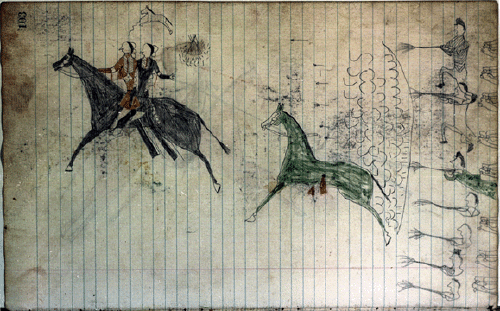
Photo: Colorado Historical Society
More About This Topic
The picture on the left was drawn about 1865 on the blank page of a ledger book. These were books Indians got from white traders. This picture was drawn by the Cheyenne artist, Red Lance. It shows the warrior White Horse (dressed in yellow) rescuing his son (sitting behind him). The son, Old Lodge Skin, had attacked the soldiers, who wounded the young man’s horse.
Their Own Words
"The picture is the rope that ties memory solidly to the stake of truth."
Source: A Lakota artist quoted in Jean Afton, et. al., Cheyenne Dog Soldiers: A Ledgerbook History of Coups and Combat (Niwot, CO: University Press of Colorado, 1997), xxvii.
Burning Julesburg
In January 7, 1865, Arapaho and Cheyenne Indians attacked Julesburg, Colorado. This drawing shows buildings in Julesburg burning while Indians on horseback watch.
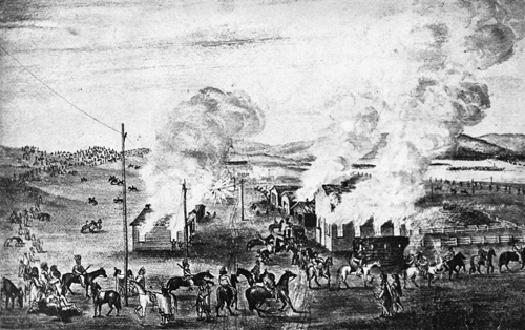
Photo: Denver Public Library, Western History Collection
More About This Topic
After the Sand Creek Massacre, the Cheyenne and Arapaho went on the war path. They attacked white farms and ranches, killed whites traveling across the plains, and burned the town of Julesburg. Peace did not return to the plains until 1868. In that year, the Cheyenne and Arapaho left Colorado to live on reservations.
Their Own Words
"But what do we have to live for? The white man has taken our country, killed our game; was not satisfied with that, but killed our wives and children. Now no peace....We have now raised the battle-axe until death."
Source: Leg-in-the-Water, a Cheyenne warrior, quoted in Donald J. Berthrong, The Southern Cheyennes (Norman, Oklahoma: University of Oklahoma Press, 1963), p. 224.
Portrait Of Nathan Meeker
This is a portrait of Nathan Meeker, a government agent who was killed by Ute Indians in 1879. He also helped start the town of Greeley. The killing of Meeker led to the removal of the northern Ute bands from Colorado.
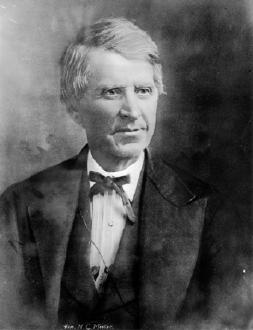
Photo: Colorado Historical Society
More About This Topic
Nathan Meeker was in charge of a Ute Indian agency in western Colorado. He tried to force the Utes to take up farming for a living. When Meeker plowed up their race track, the Utes rebelled. They killed Meeker and two other white men before soldiers put down the uprising.
Utes Sign Treaty In Washington, DC
This photo includes the Ute leaders (left to right) Ignacio, Woretsiz, Ouray, and his wife Chipeta. The white men are Secretary of the Interior Carl Schurz and General Charles Adams (standing). It was taken in 1880 in Washington, D. C., where the Ute leaders signed a treaty giving up much of their land in Colorado.
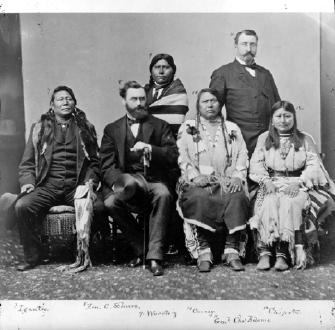
Photo: Colorado Historical Society
More About This Topic
After the Meeker uprising, whites in Colorado decided that the “Utes must go!” The men in this photo and other Ute leaders signed a treaty that removed the three northern Ute bands from Colorado. They went to live on a reservation in Utah. The three southern Ute bands agreed to live on reservations in southern Colorado.
Their Own Words
"My idea is that, unless removed by the government, they [the Utes] must necessarily be exterminated…. The state would be willing to settle the Indian trouble at its own expense. The advantages that would accrue from the throwing open of 12,000,000 acres of land to miners and settlers would more than compensate all expenses incurred."
Source: Governor Frederick Pitkin, quoted in Richard K. Young, The Ute Indians of Colorado in the Twentieth Century (Norman: University of Oklahoma Press, 1997), p. 30.
Leaving For The Reservation
In 1881, the northern Utes left Colorado to live on a reservation in Utah. This drawing shows them crossing the Colorado River on ferry boats.
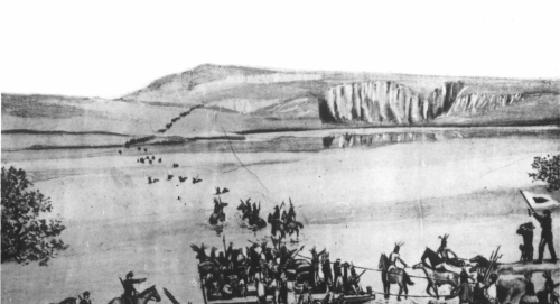
Photo: Colorado Historical Society
More About This Topic
In 1880, three Ute bands agreed to leave Colorado. These bands, the Yampa, Parianuc, and Tabeguache, were known as the White Water Utes. They moved to a reservation in Utah. The other three bands, known as the Southern Utes, were given a reservation in southern Colorado.
Band Of Utes Leaving Colorado
The Indians in this photo are Utes of the Tabeguache band. They are leaving Colorado for their reservation in Utah.
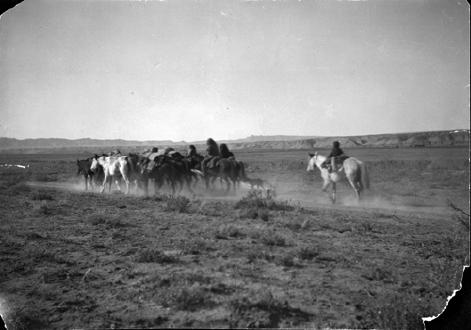
Photo: Colorado Historical Society
More About This Topic
The Southern Ute bands were the Weeminuche, Capote, and Mouache bands. In 1880, they were allowed to stay in southern Colorado. Later, the Weeminuche split apart from the other two bands. They established their own reservation, which is now the Ute Mountain Reservation. The other two bands remained on the Southern Ute Reservation.

